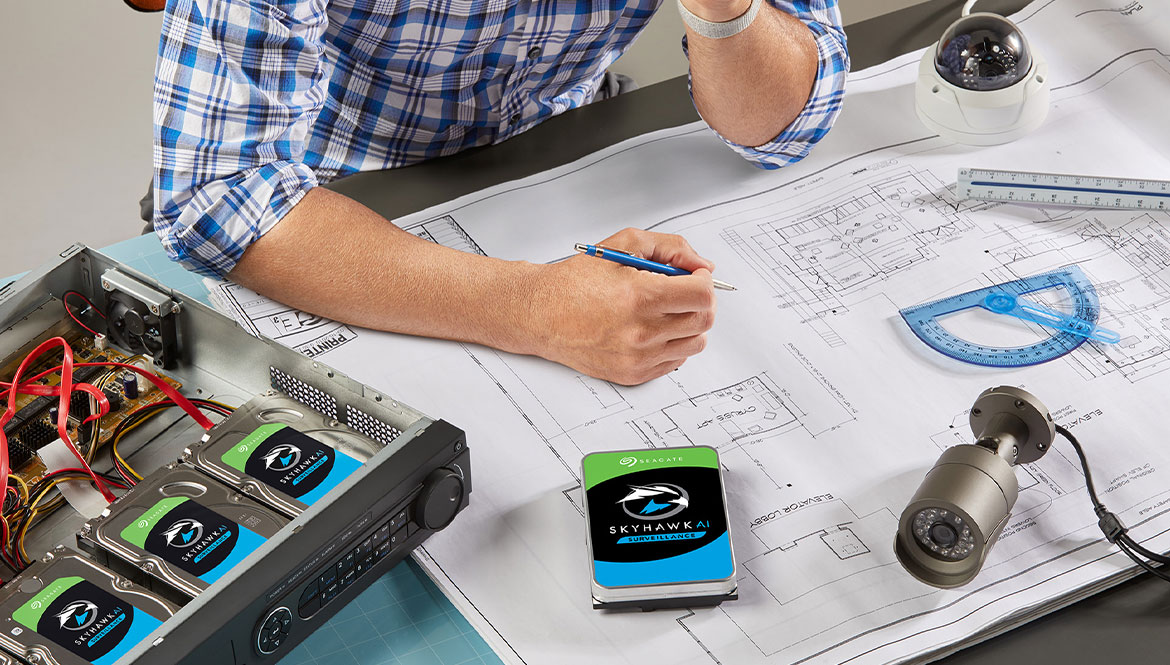You’re designing a new IP video surveillance system for a large application. When talking with your customer, they know exactly what they want for their system.
Number of cameras…Check
Type of cameras…Check
Camera resolution…Check
Storage Solution - ?
Large and small integrators alike are all too familiar with this scenario. Customers are quick to discuss the high-tech cameras they want to deploy with facial recognition, people counting, and other advanced capabilities. But they may not be as familiar with how this will affect their storage needs. To put this in perspective, the migration of deploying 1080p cameras with H.264 compression to 4K cameras with H.265 compression can still result in an increase of storage demand by 280 percent. On top of that, surveillance artificial intelligence (AI) data recording simultaneously with video means not only a heavier workload, but also much higher storage capacity. To identify your storage needs, check out Seagate Technology’s surveillance storage calculator.
As end users continue to deploy more cameras, want higher resolution, and archive video for longer retention periods, video storage can no longer be an afterthought—it must be a critical part of the video security system design and plan.
Systems integrators must consider how to maximize NVR performance, optimize storage capability, and ensure system longevity. This starts with selecting and deploying the right hard drive.
When it comes to choosing hard drives, Seagate’s SkyHawk™ surveillance drives are unmatched in their high capacity, optimized firmware, and a reliability workload rating of hundreds of terabytes per year. Designed for DVRs and NVRs, SkyHawk drives are tuned for 24×7 workloads, can support up to 64 HD cameras and up to 32 AI streams, and delivers SkyHawk Health Management for drive health monitoring.
Whether your customer needs continuous recording for video verification of alarms or deep-learning analysis to yield a business intelligence, SkyHawk has you covered and enables video surveillance systems to deliver a value beyond security.
Here are six best practices systems integrators can implement to get the most out of their SkyHawk drive and NVR storage.
- Safe Handling—Prior to installation, when removing your SkyHawk drive from shipping materials, keep it in its protective packaging until it is safely mounted in the NVR. Any mishandling, such as stacking, dropping, or shaking the drive, can result in a crash where the head assembly hits the platter, resulting in a physical scratch that affects access to data.
- Temperature—A cool, consistent air supply is needed to flow over and between hot components to extract the air. To achieve this, use high-speed fans to cool the air and ensure the hot air is exhausted without obstruction.
- Dust Elimination—In dusty or dirty environments, protect SkyHawk drives by installing dust filters or air intake ports.
- Acclimation—When transporting drives from cold to warm settings, such as from a van to an air-conditioned room, slowly acclimate the drives to avoid condensation inside the drive.
- Vibration—Multi-bay surveillance systems often subject hard drives to high fan vibration, chassis-based stimulus, and drive-to-drive excitation. Integrators can mitigate this problem by simply using a SkyHawk drive, which is equipped with rotational vibration sensors with AcuTrac® technology to ensure functionality and minimal performance degradation.
- Remote Health Monitoring Software—Use monitoring software such as SkyHawk Health Management to assess drive health and get alerts to potential issues before they happen. The result is proactive troubleshooting that makes prevention, intervention, and recovery possible. Deploying a drive with remote health monitoring software also allows integrators to provide a value-added service for maintenance contracts that can drive reoccurring monthly revenue.
By implementing these tactics and deploying SkyHawk drives, systems integrators will improve their customer’s storage capabilities while simultaneously reducing maintenance and service calls. The end result is a win-win situation where there is increased customer satisfaction and loyalty as well as increased profit margins for integrators.








